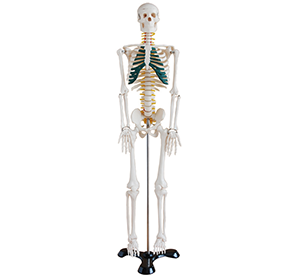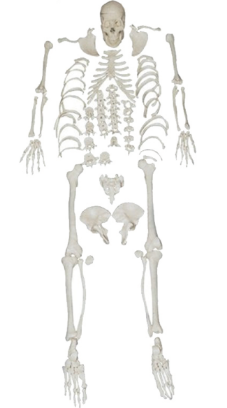
Detailed introduction of human skeleton structure of medical teaching model
Article tag: Human skeleton model medical teaching model

Human medical model skeleton, with a total of 206 bones. Among them, there are 51 trunk bones, 126 four femur bones, and 29 skull bones. Due to the different positions, functions, and shapes of bones in different parts of the human body, they are called long bones, short bones, flat bones, and irregular bones.
...
Human medical model skeleton, with a total of 206 bones. Among them, there are 51 trunk bones, 126 four femur bones, and 29 skull bones. Due to the different positions, functions, and shapes of bones in different parts of the human body, they are called long bones, short bones, flat bones, and irregular bones.

The long bones are long cylindrical, the longer section in the middle is called the diaphysis, and the ends of the long bones are enlarged, called the epiphysis. The cavity inside the backbone is called the medullary cavity, and inside it is the bone marrow. Bone marrow has hematopoietic function. Long bones are mostly distributed in the limbs, such as the ulna, radius, and femur. Most of the short bones are cubic, such as the tarsus and carpal bones. Most of the flat bones are wide and flat, plate-like, such as the parietal bones and the scapula. Irregular bones are irregularly shaped, such as vertebrae.
Human education model children have more bones than adults because children have 5 sacrums, which merge into 1 when they grow up. There are 4 to 5 coccyx in children, and one piece is also synthesized when they grow up.
Children have 2 ilium, 2 ischium, and 2 pubic bones, which merge into 2 hip bones in adults. In the end, children have 11 to 12 more bones than adults, so children's bones should actually be 217 to 218.
Generally, the 206 bones of the adult human body can be roughly divided into three parts, namely the skull, the trunk and the limbs. Teaching Model Human Skeleton Model Bone shape and name of each part, respectively, a total of 22 skulls, including frontal bone, parietal bone and so on. There are 58 bones in the trunk, including the vertebrae, sternum and ribs. There are 126 limb bones in total, including upper limb bones such as humerus, radius and ulna, and lower limb bones such as hip, femur, tibia, fibula, and calcaneus.
The 206 bones appear either singly or in pairs, each according to its different functions, in a certain way and mechanical structure, connected to each other through joints, ligaments, cartilage or sutures, etc., to form the skeletal system of the human body. Body shape, support weight and protect organs and other important functions.

Medical models Human skeleton models can be roughly divided into 4 categories according to the size and shape of the bones:
1. Short bones: approximately cubic. It is mainly located in the parts that are under pressure and move lightly, such as the carpal and calcaneus.
2. Long bones: distributed in the extremities, symmetrical and paired, mostly multi-tubular, such as the humerus, radius, ulna, femur, tibia and fibula. The middle part of the long bone is thin, called the diaphysis; the two ends are enlarged, called the epiphysis. In childhood, there is an epiphyseal cartilage between the diaphysis and the epiphysis, and it ossifies in adulthood. Long bones act as levers for support and movement.
3. Irregular bones: irregular shapes, such as hip bones, vertebrae, etc.
4. Flat bones: plate-like. Such as the parietal bones, sternum and ribs of the skull. The flat bone mainly constitutes the wall of the cavity and protects the organs in the cavity.

Marketing Center
Hong Kong, ChinaProduction Base
Shanghai, ChinaProducts
Contact Us
 Address: Hong Kong, China
Address: Hong Kong, China
 Phone:+86 19937901373
Phone:+86 19937901373
 Email:sophia@adahealthy.com
Email:sophia@adahealthy.com
 Mobile:+86-0379-65160607
Mobile:+86-0379-65160607








